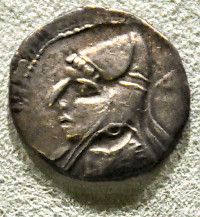Arsaces VI, Mithradates I the Great
Arsaces VI, Mithradates I the Great: Arsacid king of the Parthian Empire (r.165-132).

After the establishment of Parnian rule in the former Seleucid satrapy of Parthia by Arsaces I (r.247-211) and Arsaces II (r.211-185), the Parni may have started to shake off the Seleucid yoke under their third king, Arsaces III Phriapatius. After the two brief reigns of Arsaces IV (a son of Arsaces II; r.170-168) and Phraates I (a son of Phriapatius; r.168-165), Mithradates became the sixth king from the Arsacid house.
The reigns of Phriapatius, Arsaces IV, and Phraates are too poorly documented to state anything with certainty, but it is likely that they benefitted from the problems in the Seleucid Empire that had been caused by the defeat of Antiochus III the Great against the Romans in the Syrian War (192-188). Something similar happened in Bactria.
An attempt to restore order in the eastern satrapies by Antiochus IV Epiphanes was only partially successful because an attack by the Seleucid commander Eucratides failed (in 167 BCE) and his king died in 164 BCE. He left a very young son, Antiochus V Eupator, whose advisers were unable to deal with rival claimants. Civil wars led to the demise of the once powerful Seleucid Empire. Mithradates had a world to win.
Conquests
First, he attacked the eastern kingdom of Bactria. Having covered his rear, he moved to the west, where he conquered Media, one of the most important parts of the Seleucid Empire. Having left his brother Bagayasha as governor,note Mithradates crossed the Tigris and captured Singara and Nisibis, securing the north of Mesopotamia.
Now, Babylonia lay almost unguarded. Mithradates occupied it between 13 April and 10 June 141 BCE. He now took the title of Great King.note He also took the surname Philhellene, in spite of his wars against the Seleucids. Apparently he wanted to appease his new Greek subjects who lived in cities like Seleucia on the Tigris, Babylon, Susa and elsewhere.
In July, he captured the Seleucid capital Seleucia on the Tigris, and in October he reached Uruk in the south of Babylonia. His Seleucid enemy Demetrius II Nicator tried to reconquer his lost territories, but was defeated and - even more humiliating - caught. Two years later, Mithradates added Elam to his possessions, and probably Persis as well.
Death
In the autumn of 137 BCE, Mithradates suffered from a stroke, mentioned in the Astronomical Diaries,note and he appointed his brother Bagayasha as his substitute.note In official matters, Mithradates remained king and letters were written in his name (e.g., the letter read in Babylon on 1 November 133 BCE), but decisions were made by Bagayasha.
Mithradates died in 132. Justin writes that the great conqueror
succumbed to illness and died with glory at an advanced age, as great a man as his great-grandfather Arsaces.note
Mithradates was succeeded by his son Phraates II (r.132-127). The first tablet dated to the new king, who probably was a minor and who had his mother as regent, is dated to August 132 BCE.note Phraates was succeeded by Bagasis (r.127-126), about whom little is known, and who was quickly succeeded by Artabanus I, an uncle of Phraates.
Among the monuments he left behind is the rock relief at Hung-i Nauruzi in Khuzestan (Iran). It is not exaggerated to state that Mithradates was the real founder of the Parthian Empire.
Note
The chronology of the Arsacid kings of the Parthian Empire is less well-understood than, for example, the sequence of Seleucid and Ptolemaic kings or the emperors of Rome. This information is based on the researches by G.R.F. Assar, as published in "Iran under the Arsakids, 247 BC – AD 224/227" in: Numismatic Art of Persia (2011).